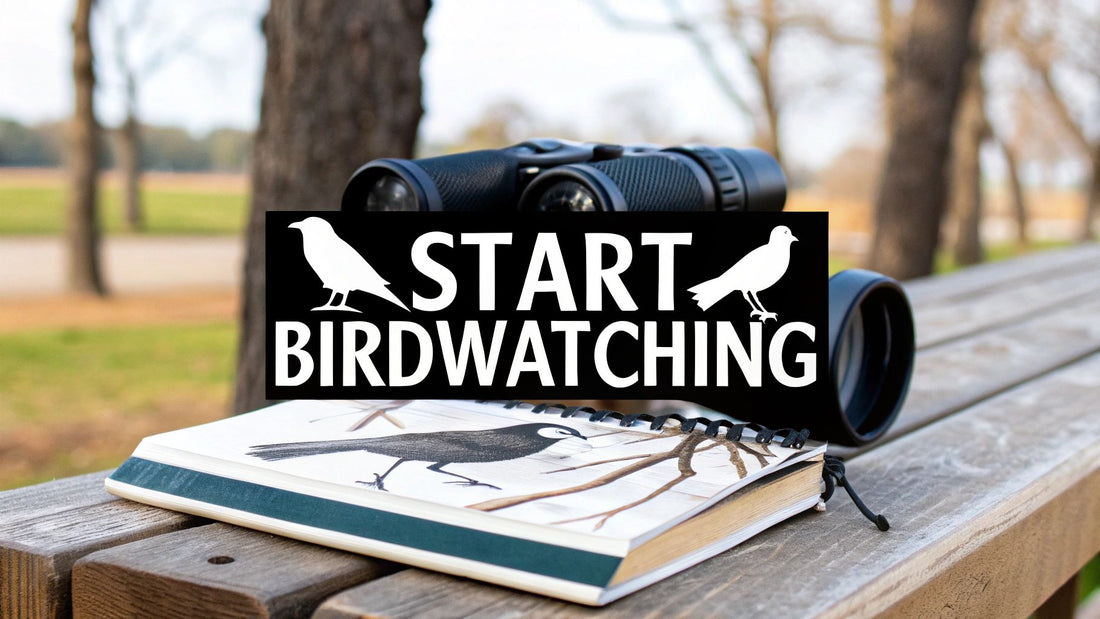You don't need a lot to start birdwatching. Honestly, all it takes is a little curiosity and a moment to just look up. You can start right now in your own backyard or at a local park—no fancy gear required. The real first step is simply noticing the birds already around you. What colors do you see? What shapes? What are they up to?
Your Birdwatching Adventure Starts Now
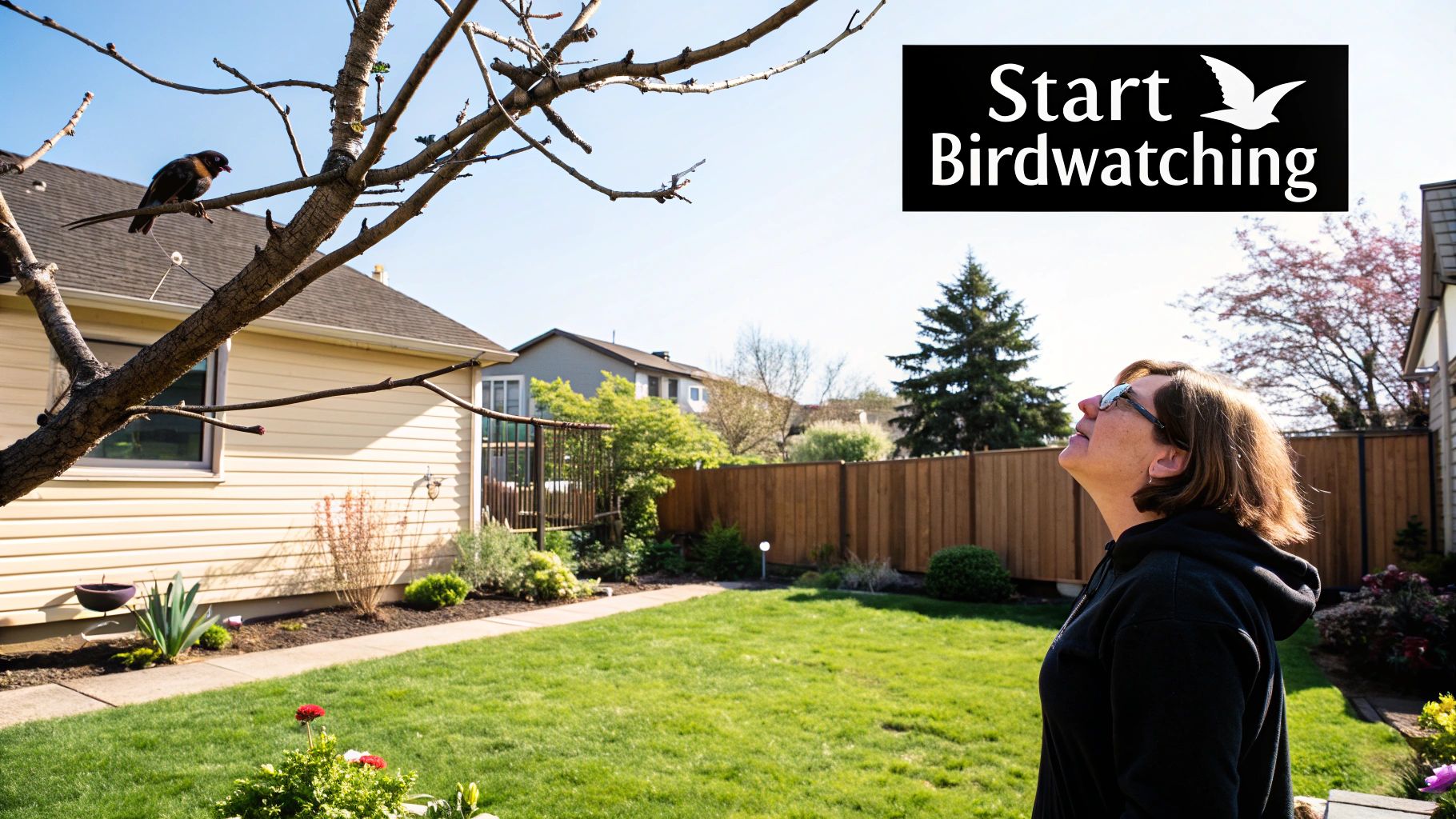
Welcome to the wonderfully simple and surprisingly addictive world of birding. This guide is all about cutting through the noise and getting straight to the good stuff: the joy of discovery. Let's forget about expensive equipment and overwhelming life lists for a minute. Instead, we'll focus on the small, easy things you can do today to kickstart a hobby that can stick with you for a lifetime.
Just by paying attention to the birds, you start to connect with the natural world in a new way. It's a fantastic stress-reliever, but it's also more than that—you can even contribute to real science. You're not alone, either. You'd be joining a massive, welcoming community.
Birdwatching is one of the fastest-growing hobbies out there. To give you an idea of the scale, platforms like the Cornell Lab of Ornithology’s eBird have logged over 1 billion bird observations from people just like you. This boom shows that even a total beginner can play a part in a huge scientific effort. If you're curious, you can learn more about this trend in this analysis of birdwatching tourism.
Getting Started Is Easier Than You Think
The best part about this hobby is how accessible it is. You don't need a biology degree to enjoy the world of birds. To get the ball rolling, I've put together a few simple steps to get you started on the right foot.
Here's a quick summary to give you an immediate action plan, breaking down the initial process into simple, manageable steps.
Your First Three Steps to Start Birdwatching
| Step | Action | Why It Matters |
|---|---|---|
| Just Look | Spend five minutes watching birds from a window or in a park. | It trains your eyes to notice movement and details you previously ignored. |
| Notice One Thing | Pick one bird and focus on a single detail—its color, size, or song. | This builds your observation skills without feeling overwhelming. |
| Ask a Question | Simply wonder, "What is that bird?" or "What's it doing?" | Curiosity is the engine of birdwatching. It's what keeps you coming back for more. |
It's really that simple. These small actions are the foundation of everything that follows.
The real magic of birdwatching isn't just about ticking species off a list; it's about learning to see the world around you with fresh eyes and a deeper appreciation for nature's quiet details.
Choosing Your First Birdwatching Tools
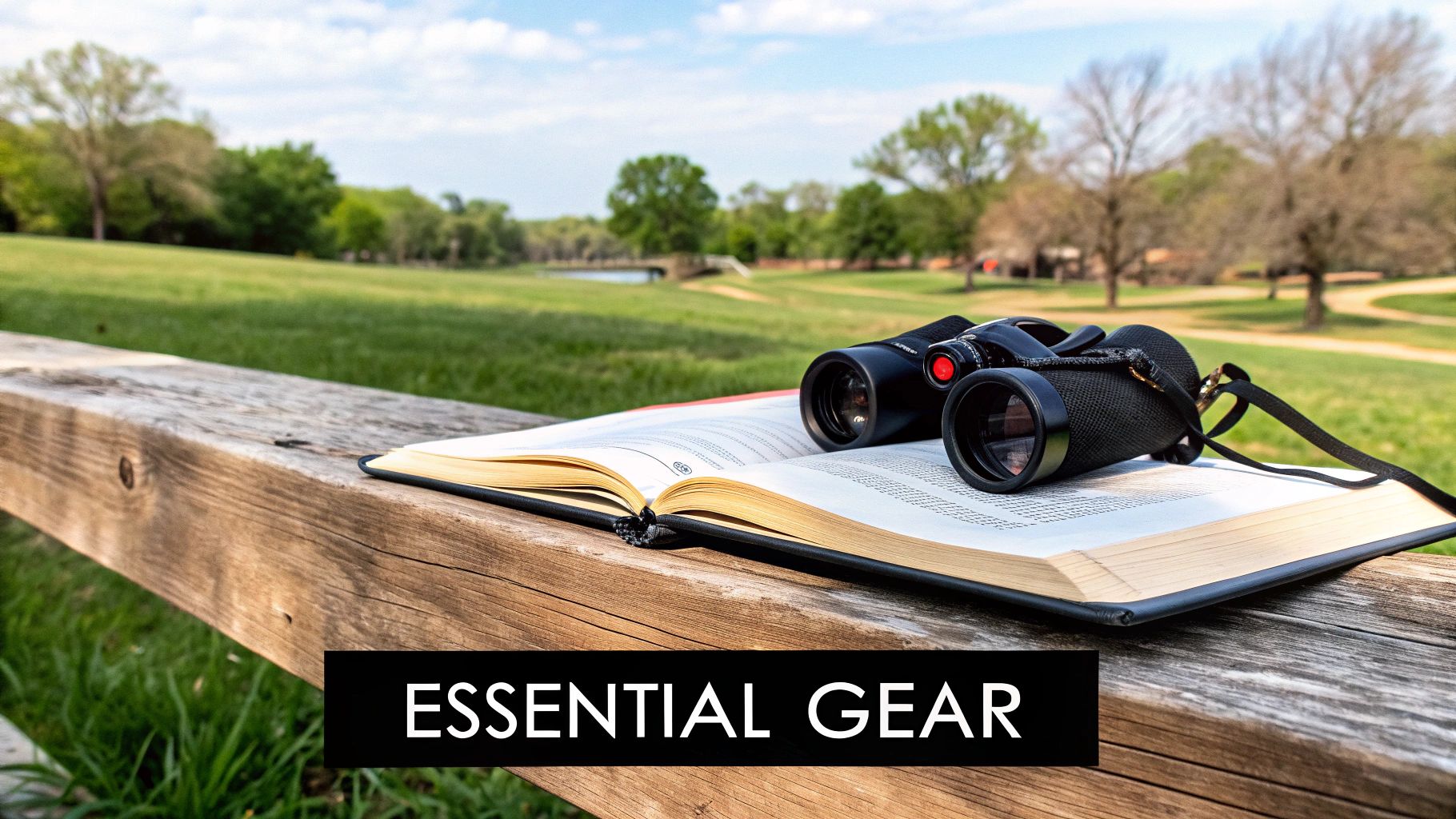
Jumping into birdwatching doesn't have to mean emptying your wallet on a mountain of gear. To go from just noticing birds to truly seeing them, you only need two things: a decent pair of binoculars and a good field guide.
These are the tools that bridge the gap between "Oh, that's a pretty brown bird" and "Wow, a female House Finch!" The right gear helps you see more, not just spend more, setting you up for years of enjoyment right from the start.
Demystifying Binoculars for Beginners
When you first shop for binoculars, you'll see a bunch of numbers like 8x42 or 10x50. They aren't just random specs; they tell you exactly what the binoculars do. The first number is the magnification—how many times closer the bird will appear. The second is the objective lens diameter in millimeters, which tells you how much light they can gather.
A classic rookie mistake is thinking more power is always better. The truth is, high-magnification 10x or 12x binoculars are notoriously hard to hold steady. The slightest hand shake turns a beautiful bird into a blurry mess, which is incredibly frustrating when you're just starting out.
For most beginners, a pair of 8x42 binoculars is the absolute sweet spot.
Here’s why I almost always recommend this setup:
- Wider Field of View: You can actually find the bird! A wider view makes it much easier to locate a warbler flitting through the treetops or to track a swift in flight.
- Brighter Image: The 42mm lens pulls in plenty of light. This is crucial for birding in the early morning or on an overcast day under a dense canopy.
- Excellent Stability: The 8x magnification is strong enough to let you see feather details but not so powerful that it magnifies every little tremor in your hands.
When you're starting out, clarity trumps raw power every time. A stable, bright view through 8x binoculars is infinitely more rewarding than a shaky, dim one through a more powerful pair.
Field Guides: Paper vs. Pixels
So you’ve got a crystal-clear look at a bird. Now what? The next puzzle is figuring out what it is, and that's where a field guide becomes your best friend. Today, you've got two great options: traditional paper guides and modern smartphone apps.
A physical book, like the classic Sibley Guide to Birds, is fantastic for studying at home. You can lay it open, flip between pages of confusingly similar sparrows, and really absorb the beautiful illustrations. There's something about the tactile experience that helps the information stick.
But out in the field, a free app like the Cornell Lab's Merlin Bird ID is an absolute game-changer. Hear a song you don’t recognize? Merlin’s Sound ID can listen and tell you what’s singing nearby. It's like having a seasoned birder right there in your pocket.
Honestly, one isn't better than the other; they just serve different needs. Most experienced birders I know use both.
Finding Birds in Your Own Neighborhood
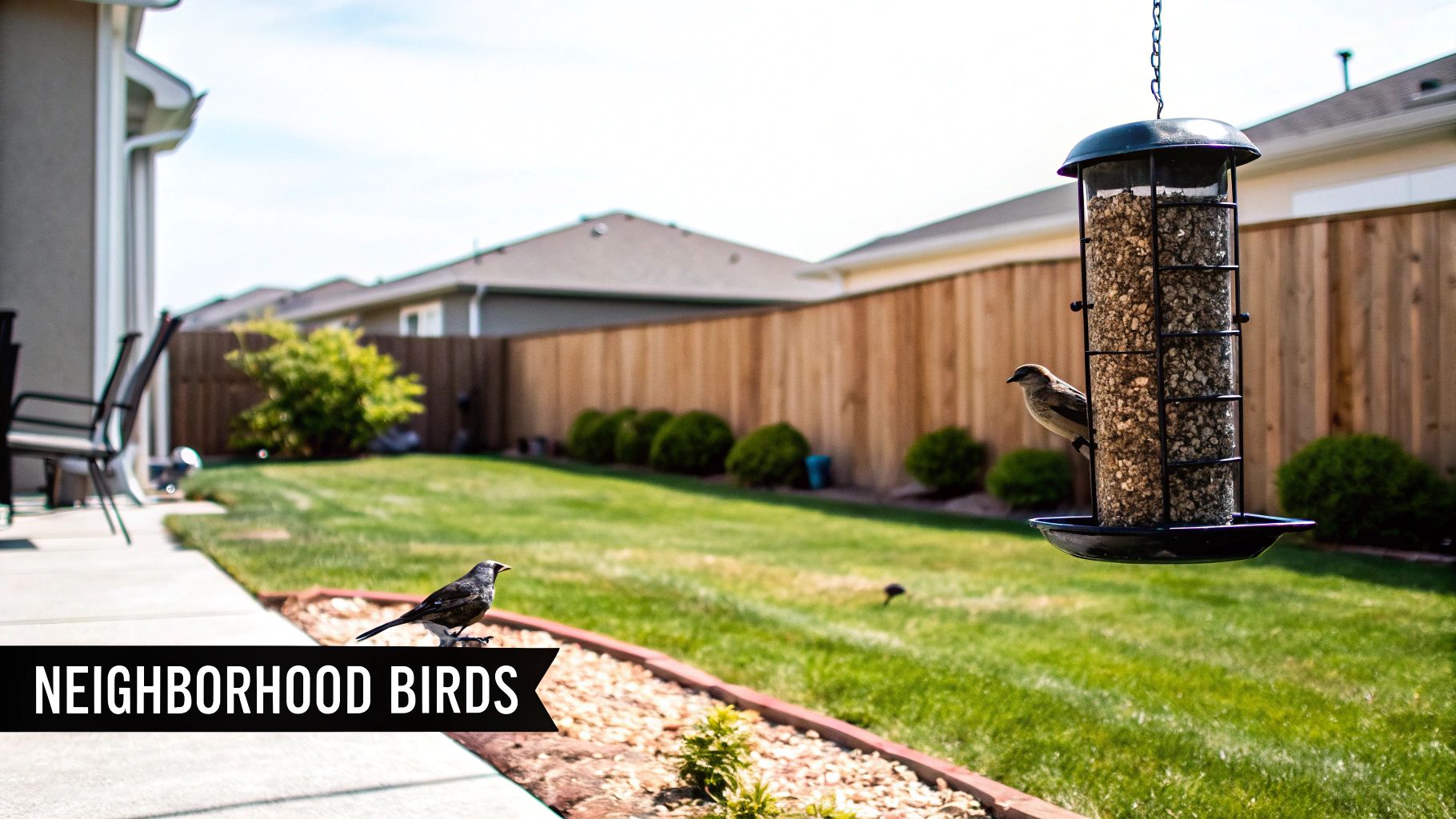
The best part about getting into birdwatching? You don’t need to plan some grand expedition. Amazing birds are probably passing through your neighborhood right now, whether you're in a city high-rise or a quiet cul-de-sac. The real trick is learning to see your familiar stomping grounds with a birder's eye.
Believe it or not, every little patch of green can be a hotspot. Your own backyard, that tiny city park with the old oak trees, or even a grassy drainage ditch can host a surprising number of birds. Each environment offers something different—food, water, or a safe place to rest.
Knowing what birds are looking for is half the battle. If you understand their diets, you can start predicting where they'll show up. For a fantastic deep dive into what wild birds eat, check out this guide. It’s amazing how a few berry bushes or a particular type of insect can turn a regular spot into a bird magnet.
Uncovering Local Hotspots
One of the most valuable (and free!) tools you can use is the eBird 'Explore' feature. It’s a massive global database where you can pull up a map of your area and see what other birders are reporting and, crucially, where. You might just discover a hidden gem you’ve driven past a hundred times, like a small pond that becomes a stopover for migrating ducks.
Don't underestimate your "patch"—that local area you can visit over and over. The real joy of birding comes from noticing the subtle seasonal shifts and the new cast of characters that arrive as the year unfolds.
Think about a standard retention pond in a housing development. In the middle of winter, maybe you'll only spot a few Mallards. But swing by that same spot during the spring migration, and it could be hosting a Great Blue Heron, or the surrounding trees might be dripping with colorful warblers.
If you’re ready to venture a bit further, you can always search for established parks and preserves. Getting to know your local spots is the perfect way to build your confidence and skills. For more ideas on finding designated viewing areas, take a look at our guide to https://williamtuckerart.com/blogs/interesting-articles/wildlife-sanctuaries-near-me.
Suddenly, a simple walk around the block becomes an exciting treasure hunt. You just have to start looking.
Learning to Identify Birds with Confidence
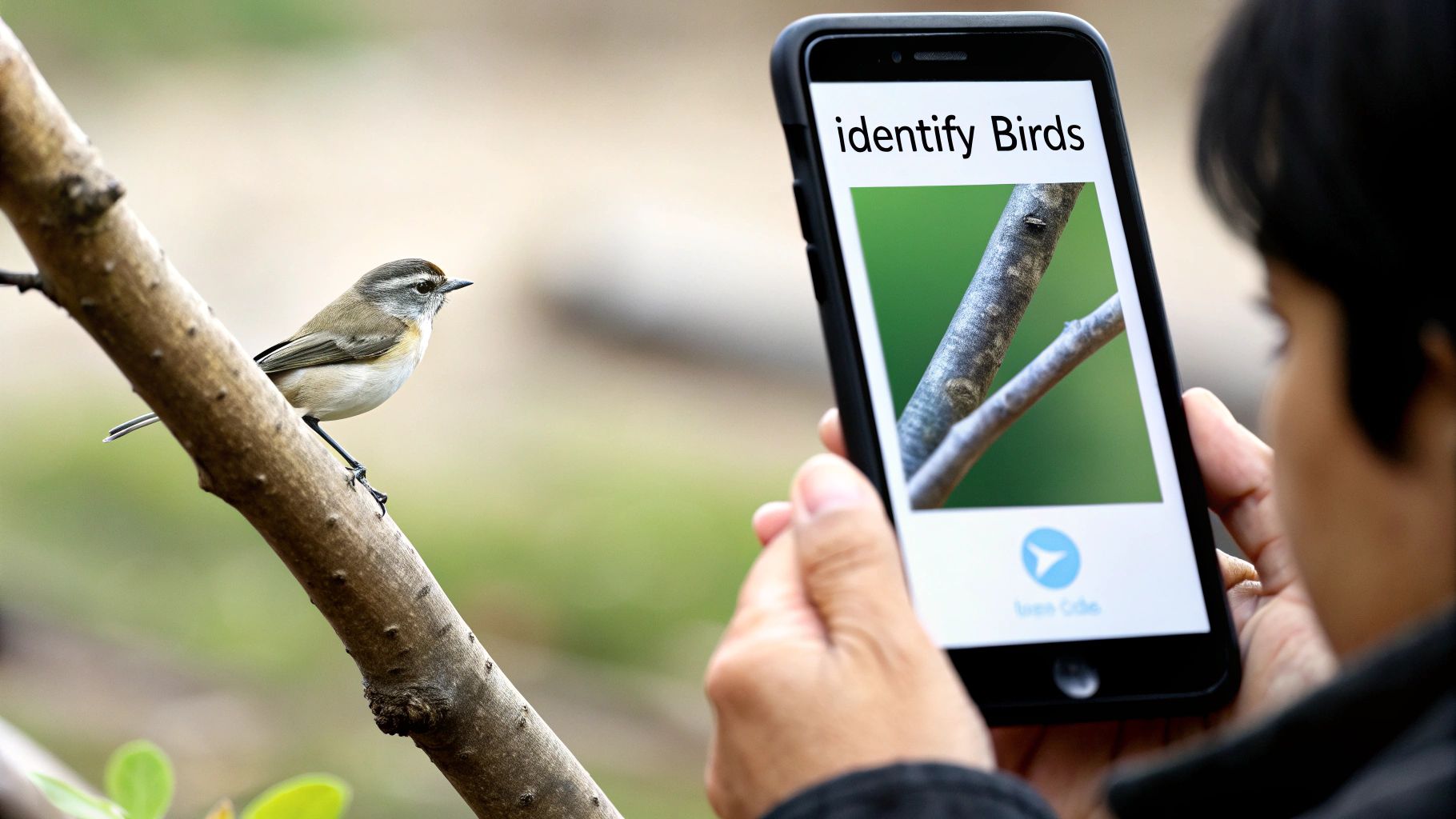
Okay, you've spotted a bird. Now what? This is where the real fun starts, but it can also feel like the most overwhelming part of getting into birdwatching. Don't fall into the trap of trying to memorize hundreds of species at once—that’s a quick path to frustration.
Instead, let’s break it down. Experienced birders have a mental checklist they run through, and it’s surprisingly simple. We call them the "four keys" to identification. This framework trains your eyes and ears to pick up on the critical clues that turn a fleeting glimpse into a confident ID.
Focus on the Four Keys to Identification
Every time you see a new bird, try to consciously check these four boxes. You won't always nail all of them, especially with a quick fly-by, but even gathering one or two pieces of information can be enough to solve the mystery.
-
Size and Shape: Before you even think about color, get a sense of the bird's general impression. Is it smaller than a sparrow? Plump like a robin, or sleek and lanky like a grackle? The beak is a dead giveaway, too. Is it short and stout for cracking seeds, or long and needle-thin for snatching insects? A finch, for example, has that classic cone-shaped bill and a stocky body, while a tiny wren has a thin, slightly curved bill perfect for pulling bugs out of crevices.
-
Color Pattern: It's tempting to just say "it was a brown bird," but the real clues are in the details. Where are the patches of color? Does it have white wingbars, a sharp stripe over its eye, or a splash of yellow on its rump? These specific patterns, what we call field marks, are far more reliable for identification than the overall color, which can look completely different depending on the light.
-
Behavior: What’s the bird doing? This is a huge clue that beginners often miss. Is it hopping along the ground like a sparrow, or confidently strutting like a starling? Maybe it's clinging sideways to a tree trunk like a nuthatch or flitting nervously at the very tips of branches. A bird's actions can tell you as much as its appearance.
-
Habitat and Song: Context is everything. Where did you see it—in a deep forest, a wide-open field, or a soggy marsh? Certain birds stick to specific environments. And don't forget to listen! Birdsong is an identifier all on its own. An app like Merlin Bird ID can literally listen to the birds around you and suggest who's singing, which is an incredible way to learn.
The goal isn't to become an expert overnight. It’s about patiently building a mental library of shapes, sounds, and behaviors. Every bird you figure out makes the next one just a little bit easier.
This whole process is a skill, and just like any other, it gets better with practice. If you want to really get good at telling similar species apart, it helps to know how to retain information better and learn faster.
It really comes down to building your observation habits, one bird at a time. The more you consciously look for these four keys, the more second-nature it becomes. You’ll be shocked at how quickly you start recognizing the regulars in your own backyard without even thinking about it.
Sharing Your Sightings to Help Birds
So, you're starting to get the hang of birdwatching. But what if I told you this new hobby of yours has a hidden superpower? Every time you identify a bird, you have the chance to become a citizen scientist, turning your passion into a powerful tool for conservation.
This is where your personal enjoyment connects to a much bigger story.
How Your Sightings Make a Real Difference
The best way to jump in is with eBird, a fantastic (and free!) project run by the Cornell Lab of Ornithology. It’s a massive online database where millions of birders from all over the world log what they see.
Think about it: this creates an incredible, real-time picture of bird life. Scientists rely on this data to track population health, map out complex migration routes, and figure out which habitats are most in need of protection.
It's Easier Than You Think
Let's say you're on your regular morning walk. You spot a couple of American Robins chasing worms and a brilliant Northern Cardinal perched on a fence. It might feel like just another Tuesday, but if you take two minutes to log that simple checklist in the eBird app, you've just contributed a valuable piece to a global puzzle. It really is that easy.
Your backyard list of sparrows and finches might seem small, but when combined with millions of others, it helps create a comprehensive, real-time map of bird life across the globe.
This collective effort has never been more critical. While estimates place the total number of wild birds on Earth at around 50 billion, that number is shrinking. North America alone has seen its bird population decline by a heartbreaking 3 billion since 1970, largely due to habitat loss. You can dig deeper into these bird population statistics on Birdfy.com.
By sharing what you see, you give scientists the information they need to understand and act on these trends. If you feel the pull to do even more, there are some incredible hands-on wildlife conservation volunteer opportunities out there that allow you to make a direct impact.
A Few Common Questions We Hear
It's totally normal to have questions when you're just starting out. Diving into a new hobby can feel a bit overwhelming, but the good news is that the birding community is one of the friendliest you'll ever find.
Here are a few things new birders often ask, along with some straightforward advice to get you going.
When’s the Best Time of Day to Actually See Birds?
If you want to see the most action, the "golden hours" are definitely early in the morning, right as the sun is coming up. This is when birds are at their busiest, singing up a storm and grabbing breakfast after a long night. The late afternoon can also be fantastic, as they have a final flurry of activity before settling down for the evening.
But honestly? The real best time to go birding is any time you can get outside. You'll start to learn the unique rhythms of your local patches—which birds show up in the midday heat and which ones prefer a cloudy afternoon. That discovery is all part of the fun.
Do I Need to Be an Expert to Get Started?
Absolutely not! The only thing you truly need is a bit of curiosity. Birdwatching is for everyone, not just people who can identify every little brown bird from a hundred yards away. You’ll be amazed at how quickly you pick things up just by paying closer attention to the birds in your own backyard.
Forget trying to know everything at once. Just start by noticing. See that robin on the lawn? Great. Hear a chirp you don't recognize? Even better. Your enthusiasm is your most important piece of gear.
How Do I Find Other Birders in My Area?
Connecting with other people is one of the fastest ways to learn and share the joy of a cool sighting. A great first step is to look up your local Audubon chapter or search for a nearby birding club. Most of them lead bird walks that are super welcoming to beginners.
Social media is also a fantastic tool. Hop on Facebook and search for birding groups for your city or state. It’s the perfect place to post a blurry photo and ask, "What on earth is this?" You'll get friendly answers and insider tips on the best local spots from people who know them inside and out.
At William Tucker Art, we believe in celebrating the beauty of the natural world through art. Explore our wildlife collections and bring a piece of nature's elegance into your home by visiting us at https://williamtuckerart.com.
